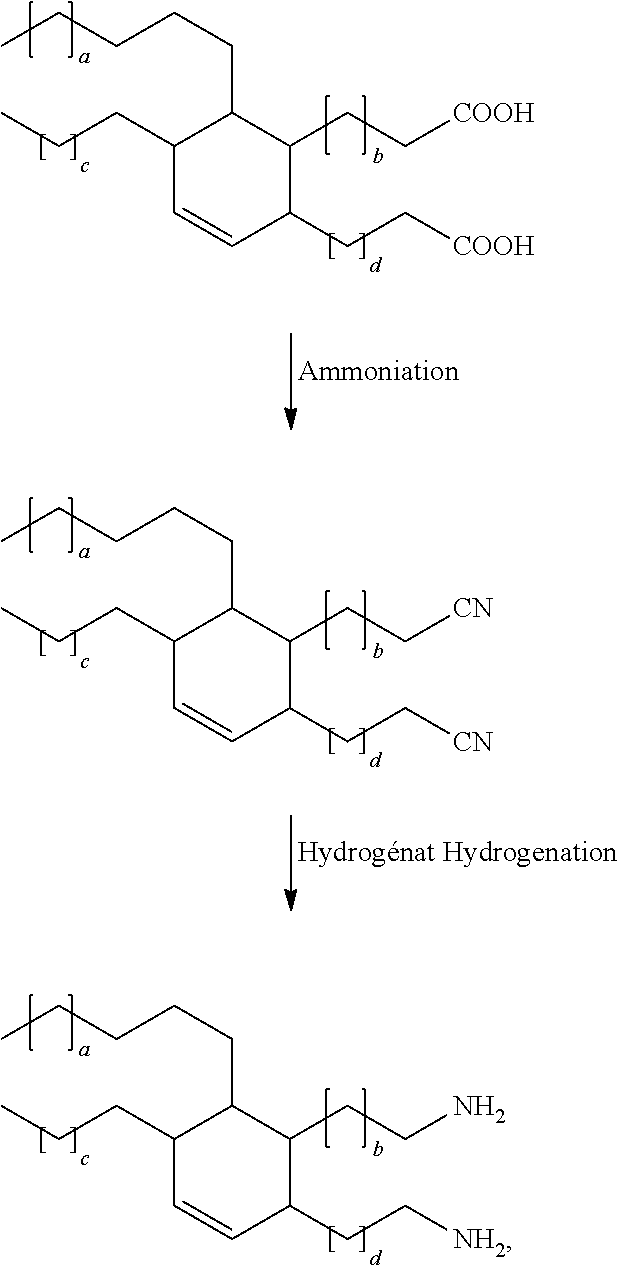Method for the synthesis of high purity primary diamines and/or triamines
a triamine and diamine technology, applied in the field of primary diamine and/or triamine synthesis, can solve the problems of polynitrile having to be distilled, and the difficulty is particularly high
- Summary
- Abstract
- Description
- Claims
- Application Information
AI Technical Summary
Benefits of technology
Problems solved by technology
Method used
Image
Examples
example 1
Synthesis of a Dinitrile from Pripol 1013
[0042]2516 g of dimerized fatty acid, sold under the name Pripol 1013 and having an acidity number of 191.9 mg of KOH / g, are charged to a predried 31 glass reactor equipped with a mechanical stirrer, electrical heating, a dephlegmator, a reflux condenser and a dry ice trap, and a system for introducing ammonia. A catalytic charge of zinc oxide of 1.57 g, i.e. 0.0625% of the weight of dimerized fatty acid employed, is added. The reaction medium is placed under stirring and then heated up to 160° C. Gaseous ammonia is then introduced at the rate of 0.417 l / min·kg. The reaction medium is brought to 300° C. The introduction of ammonia is continued until the acidity number of the reaction medium is less than 0.1 mg of KOH / g. The reaction time is approximately from 12 to 14 h. At the end of, the reaction, the reaction medium is cooled to 40° C. and the reactor is emptied. The yield is in the region of 100% and the selectivity for dinitrile is virtu...
example 2
Synthesis of a Dinitrile from Pripol 1048
[0043]2130 g of dimer / trimer fatty acid sold under the name Pripol 1048 (hydrogenated dimer and trimer acid mixture) and having an acidity number of 187.8 mg of KOH / g are charged to an installation identical to that of example 1. A catalytic charge of zinc oxide of 1.33 g, i.e. 0.0625% of the weight of fatty acid employed, is added. The reaction medium is placed under stirring and then heated up to 160° C. Gaseous ammonia is then introduced at the rate of 0.417 l / min·kg. The reaction medium is brought to 300° C. The introduction of ammonia is continued until the acidity number of the reaction medium is less than 0.1 mg of KOH / g. The reaction time is 15 h. At the end of the reaction, the reaction medium is cooled to 40° C. and the reactor is emptied. The yield is in the region of 100% and the selectivity for the nitrile functional groups is virtually 100%.
example 3
Synthesis of a Diamine from Pripol 1013
[0044]200 g of dinitrile resulting from example 1 (Pripol 1013) and 15 g of Raney nickel, filtered off and washed with isopropanol, i.e. 7.5% by weight of the initial dinitrile charge, are charged to a 500 cm3 autoclave. The reactor is closed under pressure, a check is carried for leaktightness and the reactor is rendered inert with nitrogen by compression / decompression. The gaseous ammonia is subsequently introduced at ambient temperature, which gives a pressure of 0.5 to 0.6 MPa at 25° C. This corresponds in this case to a weight from approximately 25 to 35 g of anhydrous ammonia. The reaction medium is brought to 120-130° C. with stirring and then hydrogen is introduced in order to have a total pressure of 2.3 to 2.5 MPa. Consumption of hydrogen is immediate. Monitoring is provided by measurement of the basicity as the reaction progresses. The latter lasts in the vicinity of 12 hours. At the end of the reaction, the reaction medium is cooled...
PUM
| Property | Measurement | Unit |
|---|---|---|
| total pressure | aaaaa | aaaaa |
| total pressure | aaaaa | aaaaa |
| molar ratio | aaaaa | aaaaa |
Abstract
Description
Claims
Application Information
 Login to View More
Login to View More - R&D
- Intellectual Property
- Life Sciences
- Materials
- Tech Scout
- Unparalleled Data Quality
- Higher Quality Content
- 60% Fewer Hallucinations
Browse by: Latest US Patents, China's latest patents, Technical Efficacy Thesaurus, Application Domain, Technology Topic, Popular Technical Reports.
© 2025 PatSnap. All rights reserved.Legal|Privacy policy|Modern Slavery Act Transparency Statement|Sitemap|About US| Contact US: help@patsnap.com

